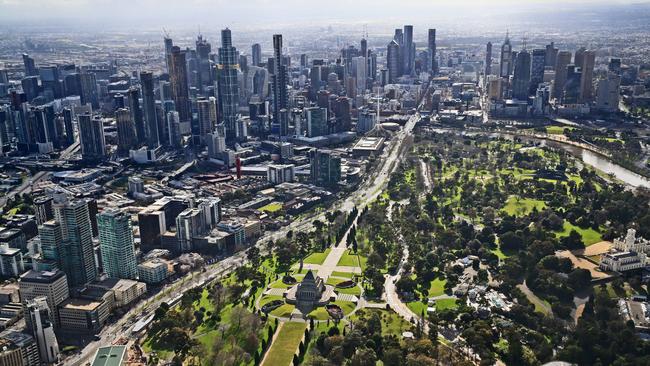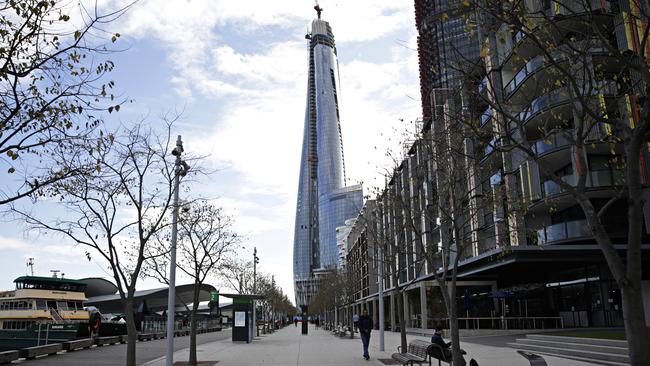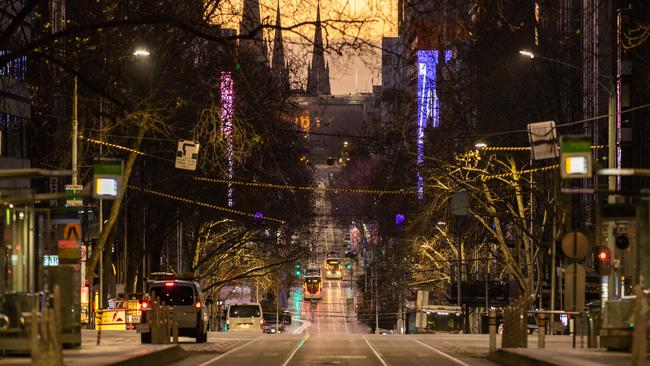Coronavirus: There’s no place like home when it comes to working
It’s been a revolution and a revelation, this unplanned and surprisingly uncomplicated exodus from the nation’s CBDs. But there is a long way to go before we realise the consequences.

Cameron Dymond knows all about offices.
He’s built a career at international firm Arup thinking about where to put the desks and water coolers, about how to design good places for people to spend their days productively and happily.
Dymond knew that after months at home during the pandemic, he would eventually have to go back to Arup’s high-rise offices in Sydney’s CBD.
So, one day recently, as companies across the city wrestled with how, when and indeed whether they should get staff back to the office, the regional commercial property leader made the half-hour trip to pick up where he and his colleagues left off in March.
It’s around noon that day when he talks to Inquirer: “Well, I’ve spent most of the time so far on my headphones participating in meetings, catch-ups, discussions, which is what I was doing from home. And at home, I didn’t have to do the commute.”
Amid the avalanche of surveys, analyses and anecdotes generated over the past five months of working from home, those comments sum up the dilemma facing up to 5.7 million Australian workers and their employers: if we can do our work from the kitchen or the living room, do we really need to go back to the office?
It’s been a revolution and a revelation, this unplanned and yet surprisingly uncomplicated exodus from the nation’s CBDs. Many wonder what took us so long, given the technology that makes the office all but obsolete for knowledge workers has been around for decades.
This week, as Victoria went dark, the rest of the country took a breath, once again uncertain about how to organise work on a more permanent basis. The CBDs of smaller cities such as Brisbane and Adelaide had been back to around 50 per cent or more occupancy of offices and Perth was at more than 80 per cent. Sydney, our biggest city, was sorting itself out, though issues around public transport and people movement in high-rise towers meant some sections — such as the glamorous Barangaroo — looked all but deserted.

Now, with Melbourne workers banned from the office till at least the middle of September and Sydney on alert for a second virus wave, is it too early to predict whether our CBDs will become hollowed-out, shabby spaces haunted by the homeless; too early to know if the “hybrid” will become the model of choice for the 46 per cent of employed Australians who have spent months at home? After all, before COVID-19, less than 2 per cent of employees worked mostly at home, and only about one-third did any work at all at home — a situation most commentators blamed on bosses’ reluctance to allow staff out of their sight.
But the stigma has disappeared and the nation’s top CEOs, interviewed by Victorian business editor Damon Kitney this week, suggest productivity has not suffered during WFH while a swag of workplace surveys reveal that between 60 and 75 per cent of workers and managers expect some level of WFH to become permanent.
Yes, there is much to do in figuring out the mix, working out the split between focused tasks that can be done anywhere on your laptop and collaboration that requires you to be in the office. Yes, performance management, indeed all management, will have to adapt and, yes, some people will decide that for mental health or efficiency that their hearts lie in the office, not at home.
But this is the fine print. The headline is clear: for many millions of people here and overseas, work will never be the same again.
Political philosopher Hannah Arendt is renowned for her phrase “the banality of evil”. But she is important too for her work on distinctions between the public and the private realm, the different spheres of human activity. Her 1958 essay, The Human Condition, is cited by Macquarie University philosopher Jean-Phillipe Deranty as he describes one consequence of WFH.
“Work and home barriers have collapsed,” says Deranty, who runs a big research project on work. “One of the arguments for why work is important is that it takes you away from home. The French psychologist, Yves Clot, writes about the psychological value of work. He says we should take seriously the different meanings of ‘occupation’ — our occupation occupies us and often stops us from being fixated on our preoccupations, our worries outside work.
“You can move away from all the worries at home when you go to the workplace. In some cases, work is a blessing and to stay at home is problematic. Political philosophers like Arendt talk about the establishment of different spheres — the home, the market and the public — but the boundaries between those spheres are collapsing.
“We don’t even have a public sphere to engage with since all the big decisions are being made by politicians and health authorities without consultation. We used to live in different spheres, but now we are finding that all the spheres are merging in the home.”
The implications for relationships and mental health are obvious but it’s worth remembering that before the Industrial Revolution work and home were as one — and we survived.
The blurring of the boundaries is not new. The pandemic has accelerated a trend, bringing a mixed bag of pluses (more time with children and partners and Netflix; respite from bullying leaders or difficult followers) and minuses (the “night shift” at the laptop; the lack of socialising; the anxieties about your promotion prospects when the boss can’t actually see you). Individuals will figure out their preferred working arrangements, and those with power will negotiate happy outcomes. Most, however, will be at the mercy of their employers’ decisions.
Top of mind for companies is the productivity of home workers and the cost of city real estate. Staff surveys and positive CEO statements only go so far, and some advocates of a return to the office argue productivity has held up only because we have been afraid of losing our jobs.
For some managers the initial glow of WFH has faded.
A recent Wall Street Journal article reported: “Projects take longer. Training is tougher. Hiring and integrating new employees, more complicated. Some employers say their workers appear less connected and bosses fear that younger professionals aren’t developing at the same rate as they would in offices, sitting next to colleagues and absorbing how they do their jobs.”

The hybrid workplace is shaping as the most favoured option after COVID-19, with workers staying home perhaps two or three days. There is much talk of redesigning commercial space to encourage interaction and innovation on the days staff are in the CBD.
A hybrid model would have only about 50 per cent of employees in the office at the same time. What will that mean for the much sought after creativity and innovation known to come from interaction?
As Dymond says: “There are a whole lot of people coming back in dribs and drabs to their offices but if you only have about 30 per cent of staff back, is that an office or is that just a very quiet place to work in? We crave closer interaction with colleagues but I think people coming back to a partially occupied office are saying to themselves, ‘What are the advantages?’. It’s not so obvious.”
Bosses are watching
One obvious advantage of the office is that it transmits what HR departments call “the culture piece” or the “DNA” of a company. New staffers often learn the “way we do things around here” by osmosis but getting recruits up to speed is difficult when staff are isolated.
Another “advantage” is that the physical office has long been a site for control, with managers able to see their staff and monitor them easily. That’s not possible with remote workers and a recent OECD paper highlighted the need for managers to change their approach — less control, more trust — if WFH is to be permanent. Against that trend, WFH has created a market for monitoring technology with companies like Humanyze helping bosses keep tabs on people at home.
Rodney Hanratty, HR chief in Australia and New Zealand at reinsurance company Swiss Re, tells Inquirer: “Surveillance is a mega trend. We are careful about it. We trust our employees and that is our default position. (But) If we had a question about someone’s productivity or whether they were performing we can track them.”
Hanratty says performance management “is really problematic” in remote work and managers need new skills to manage workers who don’t perform well in a virtual office.
Much of this comes back to communication and risk-averse executives could find it challenging to send out clear messages and avoid being sued. Some commentators talk of the need to overcommunicate when people work remotely; some suggest we may need “chief repetition officers”.
But communication between staff and with clients has proved relatively easy with all of us quickly nailing Zoom or Teams. But the technology may be tested in a hybrid world.
Arup’s Dymond recalls a recent meeting with a bunch of architects in one room and everyone else dialling in: “The people on their screens and headphones were the most successful in being able to hear each other and communicate. The people in the room can all look at each other — wink, wink, nudge, nudge — but they are not in the same meeting, it’s not equal pegging.”
No surprise then that the tech behemoths are already finessing the virtual meeting, experimenting with avatars that will sit in a virtual meeting space while their owners dial in separately. Time will tell whether fake togetherness can replace the serendipity of interaction.
Hanratty at Swiss Re is one who backs the hybrid model.
“We definitely don’t want everyone to be a tele worker,” he says. “It is a legitimate business model but we don’t want to do that. The pandemic has shown the benefits of virtual — there were some invisible boundaries that were in people’s minds about what could be done — but it has also shown the limitations.”
Swiss Re has 300 people in Australia, most of them in Barangaroo, and is part of a global firm of 15,000 employees. It is very positive about workplace flexibility and in effect argues that it doesn’t really matter where you work.
So why bother bringing them back to Barangaroo?
“There are these little moments during the day when they might be 30 seconds or two minutes,” says Hanratty.
“It is awful to characterise them all as the water cooler conversation but don’t forget, up until the pandemic, offices were designed to foster interaction. You ran into people in the kitchen and there was shared this and shared that. If you take that out, over a year you are losing a lot of knowledge and connectivity, and you don’t know what you don’t know.”
Even a 10 or 20 per cent reduction of days in the office would have a serious impact on CBD real estate but it may take some time to discern the permanent shape of Australian cities.
Designers and property analysts expect a shake-out but commercial rents are likely to fall before the towers are turned into apartments or left to the squatters.
Arup’s Dymond says planning controls in cities need to encourage more mixed use in a city like Sydney, and he predicts space will be repurposed for collaborative work. Activities could move to the suburbs with the repurposing of “white elephant” malls so they become meeting and socialising hubs located closer to where WFH workers live.
Hanratty says the risk is that our cities will become less interesting with fewer people moving in and out each day: “The CBD is perhaps the biggest artefact of our incredible reliance on this wash of students, tourists and immigrants into the centre, which elevated the whole economy. If you take 20 per cent off that wash, the CBD is not that interesting. It’s a bit less vibrant.
“I think the pandemic will provide an absolute benchmark of every country. You will be able to ask: how did you handle the pandemic? I am still hopeful that Australia will come out absolutely top of the pile. Once they switch (immigration and students) back on, we will have an extremely vibrant future.”
Toddlers and Teams
It is ironic that the reason so many women have for years sought more flexible work — the care of children — has been a big problem for remote workers during the pandemic. Paid childcare has been badly disrupted and parents have struggled — especially during Zoom conferences, it seems — but some have saved money and may want to continue to do so in future.
Before the pandemic, companies such as Swiss Re would tell staff who wanted to work from home that they could not use it as an excuse to do childminding as well.
Hanratty says: “You could not say, I am going to do a bit of childcaring, and you could not come back from maternity leave and decide to care for the child at home.”
The rules were “fuzzier” during the lockdown because parents often had no choice but to care for small children at home.
Clear rules will be needed post the pandemic but companies may have to allow people to juggle toddlers and Teams if they want to recruit and retain top talent.
On the other hand, companies will be able to hire from a national or even an international pool because physical distance and borders are irrelevant if you can work from anywhere. The tax implications for workers living in one country and employed in another are obvious but it’s easy to see that relocating to Perth from Sydney while holding onto your job is now feasible. There will be many other legal and financial issues to settle as the home is reconstituted as a workplace. Who should pay for wi-fi and insurance, for example?
For now, Australian businesses — particularly in Victoria — are in survival mode.
So too are workers and one result of the pandemic, according to some commentators, could be increased job satisfaction. A more quiescent staff, one that resets its expectations about salaries, perks or even leadership, is likely simply because those in employment will feel grateful. The pay packet rather than a caring, sharing manager will be the priority although on the plus side many will feel empowered as managers learn to trust because they can no longer control.
We didn’t plan this experiment and there is a long way to go before we have a clear idea of the results. But there is no escaping the fact that we are living through a fundamental reimagining of the working lives of many millions of Australians.
It’s too early to call the death of the office but how long before it morphs into the virtual office — whether at home or in a cafe — and the physical space provided by the employer becomes the optional extra?




To join the conversation, please log in. Don't have an account? Register
Join the conversation, you are commenting as Logout